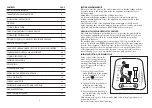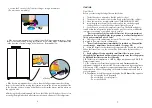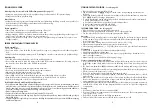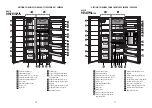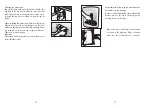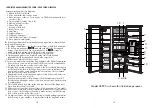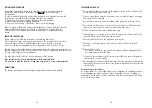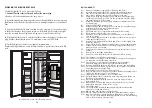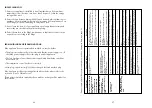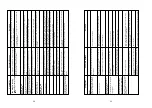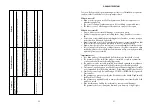
STORING FROZEN FOOD
Prepacked commercially frozen food should be stored in accordance with the
frozen food manufacturer's instructions for a
frozen food storage
compartment.
To ensure that the high quality achieved by the frozen food manufacturer and the
food retailer is maintained, the following should be remembered:
1.
Put packets in the freezer as quickly as possible after purchase.
2.
Ensure that contents are labelled and dated.
3.
Do not exceed "Use By", "Best Before" dates on the packaging.
If there is a power failure do not open the freezer door. Frozen food should not be
affected if the failure lasts for less than 8 hrs. If the failure is longer, then the
food should be checked and either eaten immediately or cooked and then re-
frozen.
FREEZING FRESH FOOD
Please observe the following instructions to obtain the best results.
Do not freeze too large a quantity at any one time. The quality of the food is best
preserved when it is frozen right through to the core as quickly as possible.
Do not exceed the freezing capacity of your appliance in 24 h which is 13 kg.
Placing warm food into the freezer compartment causes the refrigeration compressor to
operate continuously until the food is frozen solid. This can temporarily lead to excessive
cooling of the refrigeration compartment.
You may place fresh food to be frozen in any part of the freezer.
Take special care not to mix already frozen food and fresh food.
It is possible to keep the food for a long time only at -18°C or lower temperatures.
DEFROSTING
The freezer compartment and the fridge compartment defrosts automatically.
CLEANING AND CARE
** We recommend that you switch off the appliance at the socket outlet and pull
out the mains plug before cleaning.
** Never use any sharp abrasive instrument, soap, household cleaner, detergent
and wax polish for cleaning.
** Use luke warm water to clean the cabinet of the appliance and wipe it dry.
** Use a damp cloth wrung out in a solution of one teaspoon of bicarbonate of
soda to one pint of water to clean the interior and wipe it dry.
** Make sure that no water enters the lamp housing.
** If the appliance is not going to be used for a long period of time switch it off,
remove all food, clean it and leave the door ajar.
** Vacuum-clean the dusts on the appliance once a year.
** Check door seals regularly to ensure they are clean and free from food
particles.
** Removal of door tray
• To remove door racks, remove all the contents and then simply push the
door rack upwards from the base.
** To remove a freezer drawer, pull it as far as possible, and then tilt it upwards,
and then pull it out completely.
** Avoid spillage of food particularly small items like rice, peas, beans through the
fan guard as they may cause the cooling system to block and therefore operate
less efficiently.
22
23
Protection of plastic surfaces
Do not put liquid oils or oil-cooked meals in your refrigerator in unsealed containers
as they damage the plastic surfaces of your refrigerator. In case of spilling or
smearing oil on the plastic surfaces, clean and rinse the relevant part of the surface
at once with warm water.



